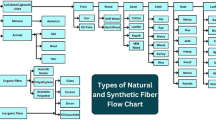Abstract
Natural fiber composites are becoming more attractive for applications as energy absorbers in the automotive industry despite their high moisture absorption characteristics. The main objective of this paper is to study the impact strength and moisture absorption properties of long fiber and short fiber hybrid composites using a kenaf/polyethylene terephthalate fiber reinforced in the polyoxymethylene matrix. The results obtained from the impact test gave 10.8 J/cm for the longer fiber hybrid composites, which is higher compared to 8.0 J/cm obtained for the short fiber hybrid composites due to less fiber pullout from the matrix. A moisture content of 0.92% and percentage water absorption of 6.77% were obtained for the long fiber composite due to poor interfacial adhesion between the fiber and the matrix. A high void content of 0.52% and porosity of 1.21% also accounted for high water and moisture absorption of the long fiber hybrid composite.






Similar content being viewed by others
References
L.J. Broutman and A. Rotem: Impact strength and toughness of fiber composite materials. In Foreign Object Impact Damage to Composite Materials. ASTM STP 568, Am. Soc. Test. Mater. 114–113 (National Technical Information Service, US Department of Commerce, Springfield VA, 1975).
A.B. Adisa and Y. Dan-mallam: Development of automobile bumper from sheep wool fiber reinforced composite. J. Nimech. 1(1), 65–73 (2009).
H. Dieter Muller and K. Andreas: Improving the impact strength of natural fiber reinforced composites by specifically designed materials and surface parameters. Int. Nonwovens J. 13(4), 31 (2004).
K. Behzad: Investigation of reinforcing filler loading on mechanical properties of wood plastic composites. World Appl. Sci. J. 13(1), 171–174 (2011).
M.N. Nahas: Radial impact strength of fiber reinforced composite tubes. J. Mater. Sci. 22(1), 657–662 (1987).
T.A. Lenda and S. Mridha: Influence of moisture absorption on impact strength and failure behaviour of hybrid jute-carbon/epoxy composite. Adv. Mater. Res. 264-265, 457–462 (2011).
L. Gisele, B.T. Maria, and L. Leandro: Water absorption behaviour and impact strength of PVC/wood floor composites. J. Chem. Chem. Technol. 4(3), 225–229 (2010).
G. Cicala, G. Cristaldi, G. Recca, and A. Latteri: Composites based on natural fiber fabrics, in Composites Based on Natural Fiber Fabrics, Woven Fabric Engineering, ( P.D. Dubrovski ed.; InTech, Italy, 2010), pp. 317–342.
K. John and S. Venkata Naidu: Sisal fiber/glass fiber reinforced hybrid composites: The impact and compressive properties. J. Reinf. Plast. Compos. 23(12), 1253–1258 (2004).
N. Alexandra, O. Constantin, M. Diana, and B. Catalina: Charpy impact on the molded polymeric parts. Acad. J. Manuf. Eng. 8(1), 85–91 (2010).
S. Padma Priya and S.K. Rai: Mechanical performance of bio fibre/glass-reinforced epoxy hybrid composites. J. Ind. Text. 35(3), 217 (2006).
K.H. Head: Manual of Soil Lab Test, 3rd ed., (Printice Press: London, 2006), pp. 150–250.
R. Nicholis: Composite Construction Materials Handbook (Printice Hall International, Inc., London, 1976), pp. 100–250.
F. Gibson: Principles of Composite Materials Mechanics (Taylor & Francis Group, CRC Press, Boca Raton, 2007), pp. 83–126.
B. Farshid, S. Vahidreza, N. Amir, and P. Srikanth: The effect of fiber length and fiber loading on the mechanical properties of wood-plastic (polypropylene) composites. Turk. J. Agric. For. 34(1), 191–196 (2010).
J.P. Siregar, S.M. Sapuan, M.Z.A. Rahman, and H.M.D.K. Zaman: The effect of alkali treatment on the mechanical properties of short pineapple leaf fiber reinforced high impact polystyrene composite. J. Food Agric. Environ. 8(2), 1103–1108 (2010).
C. Girisha, S. Sanjeevamurthy, R. Gunti, and S. Manu: Mechanical performance of natural fiber reinforced epoxy hybrid composites. Int. J. Eng. Res. Appl. 2(5), 615–619 (2012).
Y.Y. Mohd, P.T. Phongsakorn, S. Haeryip, A.R. Jeefferie, P. Puvanasvaran, A.M. Kamarul, and R. Kannan: Mechanical properties of kenaf/polyester composite. Int. J. Eng. Technol. 11, 127–131 (2011).
T.T. Law and Z.A. Mohd Ishak: Water absorption and dimensional stability of short kenaf fiber-filled polypropylene composite treated with maleated polypropylene. J. Appl. Polym. Sci. 120(1), 563–572 (2011).
A.A. Rashdi, S.M. Sapaun, M.M.H.M. Ahmad, and A. Khalina: Water absorption and tensile properties of soil buried kenaf fiber reinforced unsaturated polyester composite. J. Food Agric. Environ. 7(3–4), 908–911 (2009).
Author information
Authors and Affiliations
Corresponding author
Rights and permissions
About this article
Cite this article
Dan-mallam, Y., Abdullah, M.Z. & Megat Yosuff, P.S. Impact strength, microstructure, and water absorption properties of kenaf/polyethylene terephthalate (PET) fiber-reinforced polyoxymethylene (POM) hybrid composites. Journal of Materials Research 28, 2142–2146 (2013). https://doi.org/10.1557/jmr.2013.210
Received:
Accepted:
Published:
Issue Date:
DOI: https://doi.org/10.1557/jmr.2013.210




